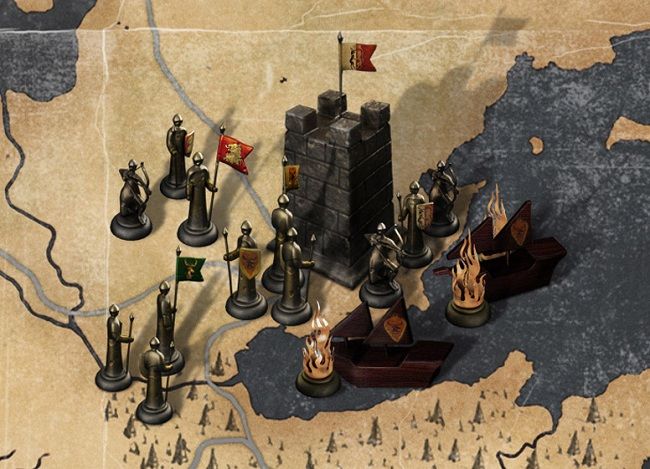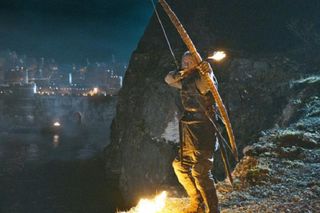Why Fire Rules Water in 'Game of Thrones'

Beware: This article contains plot spoilers for the Battle of the Blackwater in HBO's "Game of Thrones." No direct character spoilers.
Both fire and blood run as freely as water in the biggest battle yet for the HBO medieval fantasy series "Game of Thrones." The TV show's portrayal of the fictional Battle of the Blackwater provides a stark reminder of how fire has proven itself a deadly weapon in naval warfare throughout human history.
Fire ships and even unquenchable Greek fire have helped turn the tide of battles involving wooden ships — but playing with fire always comes at a risk even for the users. That double-edged nature of fire is especially clear in the "Song of Ice and Fire" book that inspired the second season of "Game of Thrones" and its depiction of the Battle of the Blackwater.
"It's as much danger to people using it as it is to the enemy," said John Hattendorf, executive director of the U.S. Naval War College Museum. "You have to control it carefully."
The attacking side of the Battle of the Blackwater features the huge fleet and army of Stannis Baratheon, younger brother to the late king of Westeros. Fighting them are the smaller sea and land forces of House Lannister, the wealthy faction that currently holds the capitol city King's Landing.
The unquenchable fire
Fire weapons look impressive (especially in TV shows and films), but did not play a huge role in most ancient or Medieval naval battles. Men won or lost such battles based on how many of the enemy they could kill with arrows, javelins, swords and axes, or based on how many enemy ships could be sunk by ramming.
Sign up for the Live Science daily newsletter now
Get the world’s most fascinating discoveries delivered straight to your inbox.
Yet the Lannister forces do deploy a potent fire weapon at the beginning of the Battle of the Blackwater to even the odds — a flammable liquid called "wildfire" that burns even on water. It's a substance that burns so hot "it melts wood, stone, even steel … and, of course, flesh," according to a pyromancer in "Game of Thrones".
Such a weapon resembles the historical "Greek fire" used by the Byzantine (Eastern Roman) Empire to win major naval battles against Arab fleets and others. The exact chemical mixture of the substance remains up for debate, but it proved unusually effective for a fire weapon.
"Most boats or ships of that period were made of wood, and so it was certainly a danger to the vessel itself," Hattendorf told InnovationNewsDaily. "It was very difficult to put out."

Lighting the fire ships
The Lannisters deploy the deadly wildfire on an unmanned ship (more than one in the "Song of Ice and Fire" book) that sails into the middle of Stannis Baratheon's attacking fleet. Such a tactic is similar to the historical use of fire ships — crewed or unmanned ships loaded with combustible materials as sacrificial fire weapons.
"Old ships were loaded with combustibles and sent against a fleet coming in on the tide or wind as a means of attacking," Hattendorf explained. "That happened in a number of places."
One such example took place during the Battle of Red Cliffs in ancient China's Three Kingdoms era, when unmanned fire ships dealt a decisive blow to a fleet that had been tied together to reduce seasickness among the troops. But fire ships became even more common in the age of sailing ships and cannons from the 16th to 19th century — the British fleet used them to help drive off the Spanish Armada's warships.
"Ships were very combustible with sail, rigging and [wood caulked with] tar," Hattendorf said. "Plus you had explosives with powder and ammunition on board."
Fighting fire on water
Warships had to take special precautions in preventing fires until water pumps became available in the modern era. Sailing ship navies often took out extra woodwork and put it in small boats towed by the warships, or simply threw combustible materials overboard before going into battle.
Even modern navies with steel warships still train rigorously for dealing with the dangers of fire caused by electrical equipment, battle damage or possibly ammunition stored aboard. The U.S. Navy has begun building a special firefighting robot to take on the dangerous duty. [Navy's Robot Firefighter to Throw Extinguisher Grenades]
Modern sailors may no longer worry about the horrors of Greek fire, but flames and smoke can still prove dangerous in the narrow corridors of steel warships. Hattendorf himself recalled escaping from an engine room fire as a young officer aboard a Navy training ship.
"We all had to escape through the flames up the ladder with the air disappearing all around us," Hattendorf said. "Nobody was hurt, but a couple million dollars of damage was done in a few minutes."
This story was provided by InnovationNewsDaily, a sister site to Live Science. You can follow InnovationNewsDaily Senior Writer Jeremy Hsu on Twitter @ScienceHsu. Follow InnovationNewsDaily on Twitter @News_Innovation, or on Facebook.












